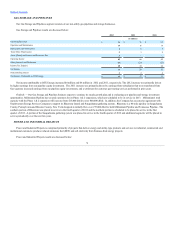DTE Energy 2012 Annual Report Download - page 43
Download and view the complete annual report
Please find page 43 of the 2012 DTE Energy annual report below. You can navigate through the pages in the report by either clicking on the pages listed below, or by using the keyword search tool below to find specific information within the annual report.
Table of Contents
As of October 1, 2012 Valuation Date:
Electric $1,208
31 % 7 % 9.0x DCF, assuming stock sale
Gas 745
21 % 7 % 10.5x DCF, assuming stock sale
Power and Industrial Projects (d) 26
70 % 9 % 10.0x DCF, assuming asset sale (e)
Gas Storage and Pipelines 22
82 % 8 % 11.0x DCF, assuming asset sale
Energy Trading 17
33 % 15 % n/a DCF, assuming asset sale
Unconventional Gas Production (f) 2
n/a
n/a
n/a Sales Price
$2,020
_______________________________________
(a) Percentage by which the fair value of equity of the reporting unit would need to decline to equal its carrying value, including goodwill.
(b) Multiple of enterprise value (sum of debt plus equity value) to earnings before interest, taxes, depreciation and amortization (EBITDA).
(c) Discounted cash flows (DCF) incorporated 2013-2017 projected cash flows plus a calculated terminal value.
(d) Power and Industrial Projects excludes Biomass and Coal Services reporting units as these units have no allocated goodwill.
(e) Asset sales were assumed except for Power and Industrial Projects' reduced emissions fuel projects, which assumed stock sales.
(f) Goodwill attributable to Unconventional Gas Production was written off in the fourth quarter of 2012 in connection with its sale. Refer to Note 7 of the Notes to
Consolidated Financial Statements in Item 8 of this Report.
We perform an annual impairment test each October. In between annual tests, we monitor our estimates and assumptions regarding estimated future cash
flows, including the impact of movements in market indicators in future quarters and will update our impairment analyses if a triggering event occurs. While
we believe our assumptions are reasonable, actual results may differ from our projections. To the extent projected results or cash flows are revised downward,
the reporting unit may be required to write down all or a portion of its goodwill, which would adversely impact our earnings.
Long-Lived Assets
We evaluate the carrying value of our long-lived assets, excluding goodwill, when circumstances indicate that the carrying value of those assets may not
be recoverable. Conditions that could have an adverse impact on the cash flows and fair value of the long-lived assets are deteriorating business climate,
condition of the asset, or plans to dispose of the asset before the end of its useful life. The review of long-lived assets for impairment requires significant
assumptions about operating strategies and estimates of future cash flows, which require assessments of current and projected market conditions. An
impairment evaluation is based on an undiscounted cash flow analysis at the lowest level for which independent cash flows of long-lived assets can be
identified from other groups of assets and liabilities. Impairment may occur when the carrying value of the asset exceeds the future undiscounted cash flows.
When the undiscounted cash flow analysis indicates a long-lived asset is not recoverable, the amount of the impairment loss is determined by measuring the
excess of the long-lived asset over its fair value. An impairment would require us to reduce both the long-lived asset and current period earnings by the amount
of the impairment, which would adversely impact our earnings.
Pension and Postretirement Costs
We sponsor defined benefit pension plans and postretirement benefit plans for eligible employees of the Company. The measurement of the plan
obligations and cost of providing benefits under these plans involve various factors, including numerous assumptions and accounting elections. When
determining the various assumptions that are required, we consider historical information as well as future expectations. The benefit costs are affected by,
among other things, the actual rate of return on plan assets, the long-term expected return on plan assets, the discount rate applied to benefit obligations, the
incidence of mortality, the expected remaining service period of plan participants, level of compensation and rate of compensation increases, employee age,
length of service, the anticipated rate of increase of health care costs and the level of benefits provided to employees and retirees. Pension and postretirement
benefit costs attributed to the segments are included with labor costs and ultimately allocated to projects within the segments, some of which are capitalized.
We had pension costs of $220 million in 2012, $172 million in 2011, and $112 million in 2010. Postretirement benefits costs were $151 million in
2012, $122 million in 2011 and $164 million in 2010. Pension and postretirement benefits costs for 2012 are calculated based upon a number of actuarial
assumptions, including an expected long-term rate of return on our plan assets of 8.25%. In developing our expected long-term rate of return assumptions, we
evaluated asset class risk and return expectations, as well as inflation assumptions. Projected returns are based on broad equity, bond and other markets. Our
2013 expected long-term rate of return on pension plan assets is based on an asset allocation assumption utilizing active investment
41
























